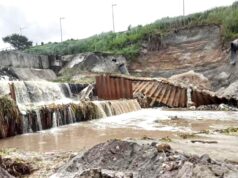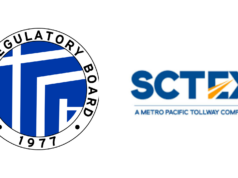(SERIOUS TALK. CILA president Dr. Irineo “Bong” Alvaro and Phivolcs Dr. Arturo Daag engage members of CAMI in post-earthquake appraisal of the freeport. Photo by Bong Lacson)
CLARK FREEPORT – “It is important to determine where liquefaction occurred.”
Thus, said Dr. Arturo Daag, chief of the Geology, Geophysics Research and Development Division of the Philippine Institute of Volcanology and Seismology (Phivolcs) in the light of the magnitude 6.1 earthquake that hit Luzon on April 22.
Daag joined Dr. Irineo “Bong” Alvaro, Jr., chair of the Clark Investors and Locators Association (CILA) at the Balitaan media forum organized by the Capampangan in Media, Inc. (CAMI) in cooperation with the Clark Development Corp. (CDC) here last Friday.
Alvaro is calling for an immediate identification of buildable and non-buildable zones in this freeport for the use of locators as he vowed to help the victims of the recent disaster.
“CDC should come up with master plan to inform CILA,” Alvaro said.
“CILA’s first activity is to come up with a technical map identifying these hazards. The quake was wakeup call,” he said.
Daag urged the CDC to immediately conduct an inspection in this freeport on where liquefaction occurred.
“Historically, Clark has pyroclastic flows and lahar. Almost half of Clark has pyroclastic flow,” Daag said.
“This was the reason for the decision of the US Air Force to evacuate the whole of Clark because of the pyroclastic flows and lahar,” he recalled.
Daag said even before 1991, Mount Pinatubo had past eruptions and lahar events that is why the ground is sandy loose and soft. He said it is not compacted especially if the water table is shallow, liquefaction will occur.
“So, the problem will be, if you have a building that is not designed properly and if the soil is soft, the building will sink,” he warned.
Daag said buildings should strictly follow the standards set in the National Building Code of the Philippines (NBCP) and National Structural Code of the Philippines (NSCP) to avoid any problems.
He said if the building is three storeys and above, there should be bore holes or standard penetration tests (SPT) conducted to provide information on the properties of the soil.
“So, in case of liquefaction the ground will soften but the building will not be affected because it is anchored on solid ground,” Daag said.
“Therefore, big buildings here should have borehole data or SPT,” he added.
“This is required by the NSCP especially if the building is big,” Daag said.
“Because liquefaction can happen in sandy loose and water saturated ground like in Minalin, Guagua, Macabebe and even in Angeles and parts of Clark, but if the water table is deep, it may not liquify,” he noted.
“That is why it is important to determine where liquefaction occurred,” he said.
Daag said the Philippines has many faults in Luzon, Visayas and Mindanao but it just so happened that the epicenter is in the boundary of Castillejos, Zambales and Porac, Pampanga.
Daag said the epicenter they plotted was at the end of the Porac-Gumain River in the Mt. Quadrado area where aftershocks also occurred there.
Alvaro observed that the 6.1 magnitude quake had an up and down shaking as well as sideways shaking as he was in front of the soon to be opened Mirej Hotel here at the time of the earthquake.
He said he was assured by structural engineers that Mirej Hotel, which will have a soft opening in October and grand opening in early December, can withstand up to a magnitude 9 earthquake.
Daag explained that the up and down shaking is caused by the proximity of Clark to the epicenter. It is the primary wave of an earthquake which usually lasts seconds while the sideways shaking is the secondary wave, he added.
“If you are near the epicenter, you will feel the up and down movement but if you are far, you won’t feel that anymore,” he said.
“Like in Manila, it was sideways only,” he added.
“So, we have a national building code and national structural code which follows strict standards on acceleration on the design of buildings. If these are followed, there should be no problem with collapsed,” he explained.




